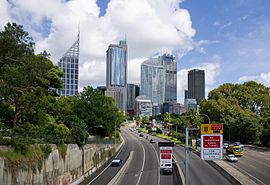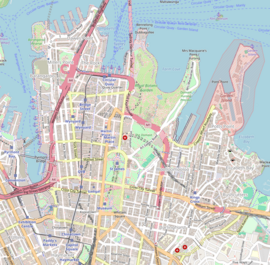Cahill Expressway
Cahill Expressway | ||
|---|---|---|
 | ||
| Cahill Expressway and the Sydney CBD, as seen looking northwest from Art Gallery Road | ||
| Coordinates |
| |
| General information | ||
| Type | Gazetted December 1964[2] | |
| Route number(s) | (Harbour Tunnel–Woolloomooloo) | |
| Former route number |
| |
| Major junctions | ||
| Northwest end | Circular Quay | |
| Highway system | ||
Cahill Expressway is an urban
It is named after the then
Route

The Cahill Expressway starts at the interchange with the Bradfield Highway and heads east as a four-lane road on the upper level of a two-level viaduct across the northern edge of the Sydney CBD at Circular Quay, before turning south at the interchange with the Sydney Harbour Tunnel and then southeast into the 371-metre (1,217 ft) Domain Tunnel, located underneath the Royal Botanic Garden.[4] It emerges soon afterwards in a cutting, then enters another tunnel under The Domain, before ending at the interchange with Cowper Wharf Road and continuing south as the Eastern Distributor. Entry ramps for the northwestern end of the Cahill Expressway also exist heading southbound along parts of the Warringah Freeway in North Sydney and the Bradfield Highway across the Harbour Bridge.
At the western end of the Cahill Expressway traffic reaches the Bradfield Highway to travel north via a tunnel under the Bradfield Highway then an anti-clockwise spiral which climbs up to the level of the Bradield highway, traversing 270° in doing so.
The expressway forms a link between Sydney's eastern and northern suburbs, by connecting the Eastern Distributor to the Sydney Harbour Bridge and Sydney Harbour Tunnel. It allows travel directly from Kingsford-Smith Airport to the northern suburbs without traffic signals. The traffic on the elevated section was reduced by half following the opening of the Sydney Harbour tunnel in 1992, but has increased again since then as the increased road capacity as a result of the construction of the tunnel has encouraged greater car usage.
The elevated section is on a double deck viaduct, with the top deck carrying the Cahill Expressway, and the lower deck the City Circle railway and Circular Quay railway station.

The expressway has a pedestrian walkway next to the traffic lanes, where great views of the Sydney Harbour Bridge and the CBD can be seen. It is accessible by stairs from Macquarie Street, or an elevator near Circular Quay railway station. The walkway connects with the Sydney Harbour Bridge walkway. The Roads & Traffic Authority offers tickets to view the New Year's Eve fireworks from the Cahill Expressway deck through a competition.[5]
Former The Sydney Morning Herald writer Elizabeth Farrelly described the freeway as 'doggedly symmetrical, profoundly deadpan, severing the city from the water on a permanent basis'.[6] The sunken section of the expressway runs between the Royal Botanical Gardens and The Domain, key green spaces in Sydney. The Botanic Gardens Trust described the expressway as destroying the spatial relationship between the two.[7] However this ignores the fact that, notwithstanding the almost constant closure of parts of The Domain to public access because of various private entertainments, there is unfettered public access to it, whereas the Botanic Gardens by contrast are heavily fenced, so that without the expressway there would still be limited movement opportunities between the two.
Demolition of the elevated section of the expressway has been proposed, most prominently by former Australian Prime Minister Paul Keating, who in 1994 offered federal funds in the amount of A$150 million toward such a project.[8][9] The then NSW Premier, John Fahey, rejected the proposal because of the cost and the resultant traffic problems.[10][11] Keating's proposal failed to take into account the necessity of the expressway for traffic, and the fact that even with removal of the expressway, the City Circle railway and Circular Quay station would remain, and need to remain because of the key role they play in Sydney's public transport system.
History

The expressway was first proposed in 1945 as part of an overall expressway plan for Sydney. Public opposition began when the proposal was first made public in 1948, with the Quay Planning Protest Committee being formed. Despite the opposition, construction on the elevated section of the expressway went ahead in 1955. Funding was provided by the Sydney Council and the NSW Government, and the elevated section was opened on 24 March 1958. Work on the second section, from Conservatorium Place through the Domain Tunnel to Cowper Wharf Road commenced almost straight away after that, and the additional section was opened on 1 March 1962.[12]
The passing of the Main Roads Act 1924
The passing of the Roads Act of 1993[18] updated road classifications and the way they could be declared within New South Wales. Under this act, Cahill Expressway retains its declaration as Main Road 592.[17]
The Cahill Expressway was signedposted as part National Route 1 from its southeastern end to the interchange with the Sydney Harbour Tunnel, when the latter opened in 1992; this was replaced with Metroad 1 in 1993. With the conversion to the newer alphanumeric system in 2013, Metroad 1 was replaced by route M1.[19]
As part of the
In June 2013, the expressway was temporarily renamed Tim Cahill Expressway in honour of Socceroo
Since 2022, Ventia has operated the Domain Tunnel on behalf of Transport for NSW.[22]
Jeffrey Smart painting
One of Australian artist Jeffrey Smart's most famous works is Cahill Expressway (1962). The painting shows a stylised view of the Cahill Expressway tunnel and approach road, with a single man shown at the side of the image. The painting shows the alienation many feel when faced with the infrastructure of large freeways, especially when closely juxtaposed with pedestrian-scale areas.[23]
Exits and interchanges
The Cahill Expressway is entirely contained within the City of Sydney local government area.
| Location | km[1] | mi | Destinations | Notes | |
|---|---|---|---|---|---|
Lane Cove | Northwestern terminus of expressway at partial trumpet interchange Entrance and exit north to the Bradfield Highway only, no access south to Western Distributor | ||||
Lane Cove | Southbound entrance and northbound exit only, route M1 continues south along the Cahill Expressway | ||||
| 1.2 | 0.75 | Conservatorium Road – Sydney CBD | Northbound entrance and southbound exit only, no access to Sydney Harbour Tunnel | ||
| 1.2– 1.6 | 0.75– 0.99 | Domain Tunnel | |||
| 1.4 | 0.87 | Shakespeare Place – Sydney CBD | Southbound entrance only | ||
| 1.7 | 1.1 | Sir John Young Crescent (north) – Woolloomooloo | Northbound entrance only | ||
Darlinghurst | Northbound entrance and southbound exit only | ||||
Wollongong, Canberra | Southwestern terminus of expressway, route M1 continues south along Eastern Distributor | ||||
1.000 mi = 1.609 km; 1.000 km = 0.621 mi
| |||||
See also
- Freeways in Australia
- Freeways in Sydney
References
- ^ a b Google (11 July 2023). "Cahill Expressway" (Map). Google Maps. Google. Retrieved 11 July 2023.
- ^ a b "Main Roads Act, 1924-1963". Government Gazette of the State of New South Wales. No. 137. National Library of Australia. 4 December 1964. p. 3910. Archived from the original on 15 May 2023. Retrieved 11 July 2023.
- ^ "1998 Special Article - The State of New South Wales - Timeline of History". Australian Bureau of Statistics. Retrieved 28 January 2007.
- ^ "Domain Tunnel". Star Group. Retrieved 30 November 2022.
- ^ "New Year's Eve in your city". Today. Channel Nine. Archived from the original on 31 December 2006. Retrieved 28 January 2007.
- ^ Farrelly, Elizabeth (3 December 2002). "Opening up the Cahill Expressway won't be a dynamic change". The Sydney Morning Herald. Retrieved 28 January 2007.
- ^ "History". Botanic Gardens Trust. NSW Department of Environment and Conservation. Archived from the original on 26 February 2007. Retrieved 28 January 2007.
- ^ "Cahill Expressway Demolition". Legislative Council Hansard (Extract). Parliament of New South Wales. 15 September 1994. Archived from the original on 20 March 2007. Retrieved 28 January 2007.
- ^ "Keating agrees to pay for removal of Cahill Expressway". The Canberra Times. Vol. 69, no. 21, 688. Australian Capital Territory, Australia. 2 September 1994. p. 4. Retrieved 27 March 2018 – via National Library of Australia.
- ^ "Fahey rejects PM's offer to demolish city expressway". The Canberra Times. Vol. 70, no. 21, 701. Australian Capital Territory, Australia. 15 September 1994. p. 5. Retrieved 27 March 2018 – via National Library of Australia.
- ^ "$50m beautification of Cahill, Quay defended". The Canberra Times. Vol. 70, no. 21, 737. Australian Capital Territory, Australia. 22 October 1994. p. 6. Retrieved 27 March 2018 – via National Library of Australia.
- ^ "How to Build a Street". Sydney Streets. City of Sydney. Archived from the original on 17 March 2007. Retrieved 28 January 2007.
- ^ State of New South Wales, An Act to provide for the better construction, maintenance, and financing of main roads; to provide for developmental roads; to constitute a Main Roads Board Archived 11 August 2022 at the Wayback Machine 10 November 1924
- ^ State of New South Wales, An Act to amend the Main Roads Act, 1924-1927; to confer certain further powers upon the Main Roads Board; to amend the Local Government Act 1919, and certain other Acts; to validate certain payments and other matters; and for purposes connected therewith. Archived 12 August 2022 at the Wayback Machine 8 April 1929
- ^ "State Roads Act". Government Gazette of the State of New South Wales. No. 7. National Library of Australia. 22 January 1993. pp. 223–30. Archived from the original on 27 March 2023. Retrieved 11 July 2023.
- ^ "Roads Act 1993" (PDF). Government Gazette of the State of New South Wales. No. 124. Legislation NSW. 8 August 2003. p. 7885. Archived (PDF) from the original on 31 March 2019. Retrieved 11 July 2023.
- ^ a b Transport for NSW (August 2022). "Schedule of Classified Roads and Unclassified Regional Roads" (PDF). Government of New South Wales. Archived from the original (PDF) on 25 August 2022. Retrieved 1 August 2022.
- ^ State of New South Wales, An Act to make provision with respect to the roads of New South Wales; to repeal the State Roads Act 1986, the Crown and Other Roads Act 1990 and certain other enactments; and for other purposes. Archived 11 August 2022 at the Wayback Machine 10 November 1924
- ^ "Road number and name changes in Sydney" (PDF). Roads and Maritime Services. Transport for NSW - Roads and Maritime. 2013. Archived from the original (PDF) on 1 April 2019. Retrieved 23 July 2020.
- ^ "Proposed Eastern Distributor: Cahill Expressway to Mill Pond Road: volume 1: environmental impact assessment" (PDF). OpenGov NSW. Department of Urban Affairs and Planning. 2 June 1997. Retrieved 24 August 2021.
- ^ O'Brien, Thomas (17 June 2013). "The fast road to Brazil: Cahill's personal route to Rio". The Sydney Morning Herald.
- ^ "Sydney Harbour Tunnel". Transport for NSW. Retrieved 30 November 2022.
- ^ Corkery, Noel. "Re:Engineering The Landscape" (PDF). Archived from the original (PDF) on 25 March 2012. Retrieved 15 August 2012.
External links
- Ashton, Paul (2008). "Cahill Expressway". Dictionary of Sydney. Retrieved 24 September 2015. [CC-By-SA]
![]() Media related to Cahill Expressway at Wikimedia Commons
Media related to Cahill Expressway at Wikimedia Commons

